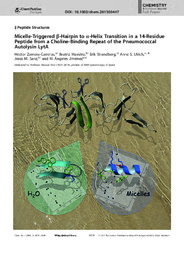Por favor, use este identificador para citar o enlazar este ítem:
https://hdl.handle.net/11000/30956
Micelle-Triggered b-Hairpin to a-Helix Transition in a 14-Residue Peptide from aBinding
Choline- Repeat of the Pneumococcal Autolysin LytA
Título :
Micelle-Triggered b-Hairpin to a-Helix Transition in a 14-Residue Peptide from aBinding
Choline- Repeat of the Pneumococcal Autolysin LytA |
Autor :
Zamora-Carreras, Héctor
Maestro, Beatriz
Strandberg, Erik
Ulrich, Anne S.
Sanz, Jesús M.
Jiménez, M. Ángeles |
Editor :
Willey on line Library |
Fecha de publicación:
2015 |
URI :
https://hdl.handle.net/11000/30956 |
Resumen :
Choline-binding modules (CBMs) have a bb-solenoid structure composed of choline-binding repeats (CBR), which consist of a b-hairpin followed by a short linker. To
find minimal peptides that are able to maintain the CBR native structure and to evaluate their remaining cholinebinding ability, we have analysed the third b-hairpin of the
CBM from the pneumococcal LytA autolysin. Circular dichroism and NMR data reveal that this peptide forms a highly stable native-like b-hairpin both in aqueous solution and in
the presence of trifluoroethanol, but, strikingly, the peptide structure is a stable amphipathic a-helix in both zwitterionic (dodecylphosphocholine) and anionic (sodium dodecylsulfate) detergent micelles, as well as in small unilamellar vesicles.
This b-hairpin to a-helix conversion is reversible. Given that the b-hairpin and a-helix differ greatly in the distribution of hydrophobic and hydrophilic side chains, we propose
that the amphipathicity is a requirement for a peptide structure to interact and to be stable in micelles or lipid vesicles. To our knowledge, this “chameleonic” behaviour is the only described case of a micelle-induced structural transition between two ordered peptide structures.
|
Palabras clave/Materias:
micelles
protein folding
protein structures
structural biology
structural elucidation |
Tipo documento :
application/pdf |
Derechos de acceso:
info:eu-repo/semantics/openAccess |
DOI :
https://doi.org/10.1002/chem.201500447 |
Aparece en las colecciones:
Instituto de Bioingeniería
|
 La licencia se describe como: Atribución-NonComercial-NoDerivada 4.0 Internacional.
La licencia se describe como: Atribución-NonComercial-NoDerivada 4.0 Internacional.

 La licencia se describe como: Atribución-NonComercial-NoDerivada 4.0 Internacional.
La licencia se describe como: Atribución-NonComercial-NoDerivada 4.0 Internacional.
.png)